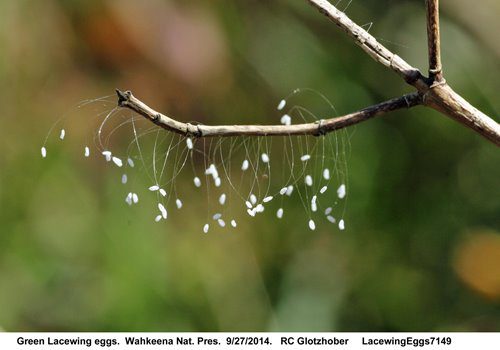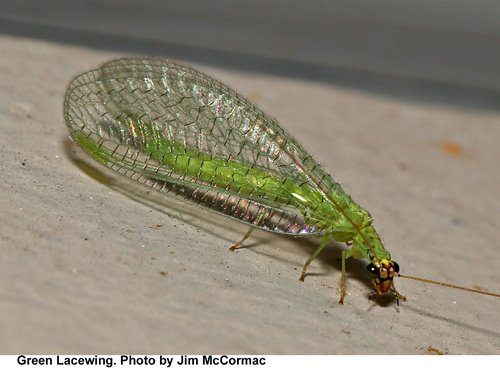This is something that apparently people have not noticed very often, so here’s Bob’s answer to this week’s puzzling “Freak”.

These are the eggs of the Green Lacewing. Green Lacewings are in the family Chrysopidae, in the insect order Neuroptera. The order also includes fishflies, snakeflies, and antlions.
The eggs were found hanging on a branch along the wetland boardwalk at Wahkeena Nature Preserve on September 25th. The eggs themselves are only about 1 or 2 mm long, with the silky looking stalk less than half an inch. Female lacewings typically lay 100 to 200 eggs – so this is only a small part of a total clutch. Lacewings apparently have learned not to “put all their eggs in one basket (branch or leaf)”. The eggs are reported to typically hatch in the fall, with the lacewings overwintering in a prepupa stage, or in some species as a newly hatched adult.
 Adult Green Lacewings are attractive, delicate looking insects. Their wings certainly fit their name, as they look like oblong lace doilys, except that what would be an empty space in a doily is filled with a filmy, transparent membrane. Size varies, but most are less than half an inch long. The photo here is compliments of Jim Mccormac.
Adult Green Lacewings are attractive, delicate looking insects. Their wings certainly fit their name, as they look like oblong lace doilys, except that what would be an empty space in a doily is filled with a filmy, transparent membrane. Size varies, but most are less than half an inch long. The photo here is compliments of Jim Mccormac.
While some lacewings feed on pollen and nectar of flowers, the most common Green Lacewing is almost totally predaceous. The eggs hatch into a larva which looks a lot like an antlion, a small six-legged crawling tank with huge jaws on the front. The larvae crawl up the egg stalk, and then begin to look for aphids. Due to the aggressive appetite of both larvae and adults, they are sometimes called “aphid lions.” Organic gardeners sometimes purchase lacewing eggs, with recommendations of releasing 1,000 eggs in every 200 square feet of garden! Some sources suggest rather than buying eggs, to promote plants that seem to favor lacewings. These include some beauties, like cosmos, various sunflowers and dill – but also include things like dandelions and angelica.
The lacewing larvae are really quite an interesting predator. In areas where aphids are abundant, they crawl around waving their head from side to side – and if their maxillae strike something, they grab it. The maxillae are hollow, and they inject a digestive enzyme into the aphid – which can dissolve the aphids’ tissues in as little as 90 seconds into a slurry that the lacewing sucks up. Sounds like great material for a Sci-Fi movie! Get your favorite beverage and some popcorn and sit in front of the TV for a late-night freaky thriller. Or better yet, just scan the undergrowth of your backyard or favorite park for the real thing!
Bob Glotzhober
Curator Emeritus of Natural History